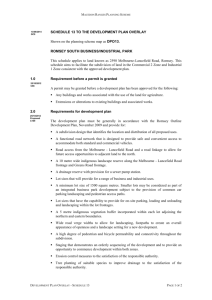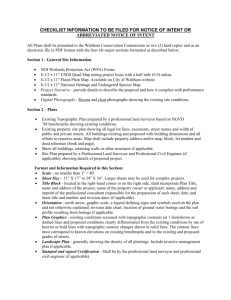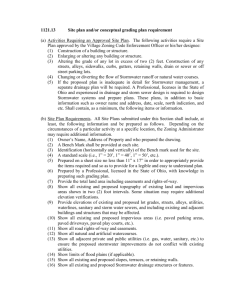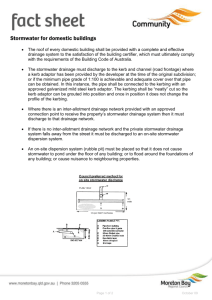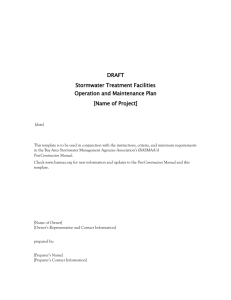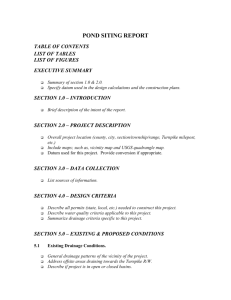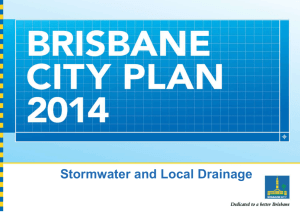21_mss11_mona - Department of Transport, Planning and
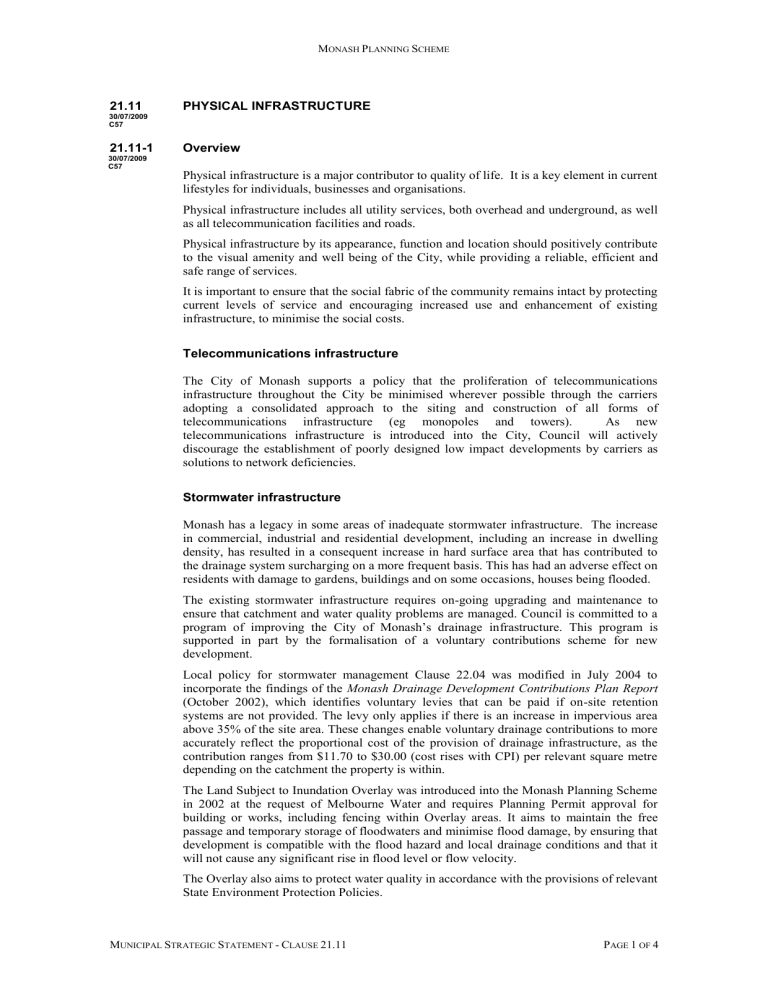
M ONASH P LANNING S CHEME
21.11
30/07/2009
C57
21.11-1
30/07/2009
C57
PHYSICAL INFRASTRUCTURE
Overview
Physical infrastructure is a major contributor to quality of life. It is a key element in current lifestyles for individuals, businesses and organisations.
Physical infrastructure includes all utility services, both overhead and underground, as well as all telecommunication facilities and roads.
Physical infrastructure by its appearance, function and location should positively contribute to the visual amenity and well being of the City, while providing a reliable, efficient and safe range of services.
It is important to ensure that the social fabric of the community remains intact by protecting current levels of service and encouraging increased use and enhancement of existing infrastructure, to minimise the social costs.
Telecommunications infrastructure
The City of Monash supports a policy that the proliferation of telecommunications infrastructure throughout the City be minimised wherever possible through the carriers adopting a consolidated approach to the siting and construction of all forms of telecommunications infrastructure (eg monopoles and towers). As new telecommunications infrastructure is introduced into the City, Council will actively discourage the establishment of poorly designed low impact developments by carriers as solutions to network deficiencies.
Stormwater infrastructure
Monash has a legacy in some areas of inadequate stormwater infrastructure. The increase in commercial, industrial and residential development, including an increase in dwelling density, has resulted in a consequent increase in hard surface area that has contributed to the drainage system surcharging on a more frequent basis. This has had an adverse effect on residents with damage to gardens, buildings and on some occasions, houses being flooded.
The existing stormwater infrastructure requires on-going upgrading and maintenance to ensure that catchment and water quality problems are managed. Council is committed to a program of improving the City of Monash’s drainage infrastructure. This program is supported in part by the formalisation of a voluntary contributions scheme for new development.
Local policy for stormwater management Clause 22.04 was modified in July 2004 to incorporate the findings of the Monash Drainage Development Contributions Plan Report
(October 2002), which identifies voluntary levies that can be paid if on-site retention systems are not provided. The levy only applies if there is an increase in impervious area above 35% of the site area. These changes enable voluntary drainage contributions to more accurately reflect the proportional cost of the provision of drainage infrastructure, as the contribution ranges from $11.70 to $30.00 (cost rises with CPI) per relevant square metre depending on the catchment the property is within.
The Land Subject to Inundation Overlay was introduced into the Monash Planning Scheme in 2002 at the request of Melbourne Water and requires Planning Permit approval for building or works, including fencing within Overlay areas. It aims to maintain the free passage and temporary storage of floodwaters and minimise flood damage, by ensuring that development is compatible with the flood hazard and local drainage conditions and that it will not cause any significant rise in flood level or flow velocity.
The Overlay also aims to protect water quality in accordance with the provisions of relevant
State Environment Protection Policies.
M UNICIPAL S TRATEGIC S TATEMENT C LAUSE 21.11 P AGE 1 OF 4
M ONASH P LANNING S CHEME
Land affected by the Land Subject to Inundation Overlay was identified, by Melbourne
Water, as having the potential for inundation from an open watercourse during a severe storm of 1 in 100 year intensity. These areas are distributed throughout the City of Monash, generally along watercourses.
The Special Building Overlay may also be used to identify land in urban areas that is prone to inundation by overland flows from the urban drainage system. Applications for development within the Special Building Overlay area must meet additional requirements to permit assessment of potential impacts from the drainage system.
21.11-2
30/07/2009
C57
Key issues
Maintenance of physical infrastructure remains a major cost for Monash. The ongoing maintenance and upgrading of assets should be continuous. The cost of infrastructure will be borne by the existing and future rate base, however it needs to be recognised in funding programs that any major upgrade will need to be scheduled over several budget years.
New developments in areas of identified stormwater capacity shortfall should contribute to drainage upgrading works, both in the qualitative and quantitative aspects.
Providers of physical infrastructure have a responsibility to the wider community to ensure that they utilise “best practice” principles in the siting and provision of their services.
Stormwater needs to be managed to minimise its impact and to improve water quality.
It should be considered as a resource rather than a waste product, particularly in light of our noticeably drying climate.
21.11-3
30/07/2009
C57
Objectives, strategies and implementation
Objectives
To provide a reliable, efficient and safe range of physical infrastructure for the residents and businesses in the City including roads, drains and essential services.
To ensure that new development provides appropriate infrastructure, particularly where it is likely to impact on the capacity of the existing infrastructure.
To promote development which maximises existing infrastructure in appropriate areas, such as around nodes of existing services.
To improve stormwater management so that stormwater is used effectively and efficiently to minimise its impact on the environment and reduce the use of potable water in external areas.
To ensure that infrastructure facilities have minimal impact on visual character and amenity.
To protect drainage assets from the adverse impact of development and redevelopment.
To manage flows within both the major and minor drainage systems.
Strategies
Ensure that local amenity is not disadvantaged by the provision of physical infrastructure.
M UNICIPAL S TRATEGIC S TATEMENT C LAUSE 21.11 P AGE 2 OF 4
M ONASH P LANNING S CHEME
Provide seats for people to rest in easily accessible positions such as along shared paths, arranged to facilitate social interaction and aligned with attractive vistas and points of special interest.
Use signage to add character and interest to the streetscape which provides clear direction to points of interest.
Provide appropriate lighting in areas intended for night use and/or areas accessed by pedestrians after dark.
Encourage appropriate location and form of telecommunications infrastructure, having regard to its potential impact on nearby buildings and amenity.
Reduce flooding potential throughout Monash through improved drainage and flood mitigation works, including restricting uses and development within the 1 in 100 year floodplain, consistent with the Land Subject to Inundation Overlay and Special
Building Overlay.
Ensure that the quality and quantity of stormwater runoff is appropriate for the receiving environment.
Promote utilisation of best practice water sensitive design techniques that use nonstructural devices to reduce the amount of pollutants entering the stormwater system, and structural devices to intercept pollutants that have already entered the system.
Promote strategies to reuse stormwater where its quality is fit for purpose.
Make appropriate provision for siting of waste disposal facilities.
Minimise the risk to life and property from a major storm event and manage nuisance flows from any storm event, as urban redevelopment continues to occur.
Require all development proposals to demonstrate that there will be no detrimental affect on physical infrastructure in respect of its appearance, function, location, visual amenity, reliability, efficiency or safety.
Ensure that the development of land which is subject to any overland flow is subject to floodplain management requirements.
Implementation
These strategies will be implemented by:
Policy and exercise of discretion
Using local policy to ensure that all development addresses impacts on existing infrastructure. (Residential Development and Character policy, Clause 22.01, Industry and Business Development and Character policy, Clause 22.03, Stormwater
Management policy, Clause 22.04 and Tree Conservation policy, Clause 22.05).
Zones and overlays
Applying, in particular, the Urban Floodway Zone.
Applying the Vegetation Protection Overlay to appropriate areas.
Applying a Land Subject to Inundation Overlay to land which has been identified by
Melbourne Water as being subject to flooding during 1 in 100 year flood events.
Applying the Special Building Overlay to land affected by overland flows in storm events that exceed the capacity of the underground drainage systems.
M UNICIPAL S TRATEGIC S TATEMENT C LAUSE 21.11 P AGE 3 OF 4
M ONASH P LANNING S CHEME
Further strategic work
Investigating and preparing, where appropriate, drainage and nutrient management plans for major wetlands and open space areas which contribute to the stormwater drainage system.
21.11-4
30/07/2009
C57
Other actions
Developing an integrated asset management system for all Council infrastructure to revitalise and rationalise Council assets and, where appropriate, encourage multiple use of facilities.
Working with owners and occupiers to introduce improved stormwater management practices where established uses are contributing to poor stormwater quality.
Making provision for Council expenditure under its Capital Works Program to address drainage infrastructure problems as identified in:
Drainage Strategy Study, City of Waverley (November 1991).
Drainage Improvement Strategy - Yarra River Catchments, City of Waverley
(August 1993).
Drainage Improvement Strategy - Dandenong Creek Catchments, City of Waverley
(1994).
Oakleigh Stormwater Drainage Study - City of Monash (EGIS - November 2002).
Reference documents
Drainage Strategy Study : final report, Binnie & Partners consulting Engineers, November
1991
Monash Drainage Strategy Report (MDSR), October 2002. GHD, July 2004
Drainage Improvement Strategy: Dandenong Creek Catchments, Consulting Drainage
Engineer, November 1994
Drainage Improvement Strategy - Yarra River Catchments, City of Waverley, August 1993
Mile Creek East Catchment Drainage - Report on Total Catchment Strategy, 1997
Monash Conservation and Environment Strategy, City of Monash, 1998.
Oakleigh Stormwater Drainage Study (EGIS), 2002
Code of Practice for Telecommunications Facilities in Victoria, July 2004
M UNICIPAL S TRATEGIC S TATEMENT C LAUSE 21.11 P AGE 4 OF 4

